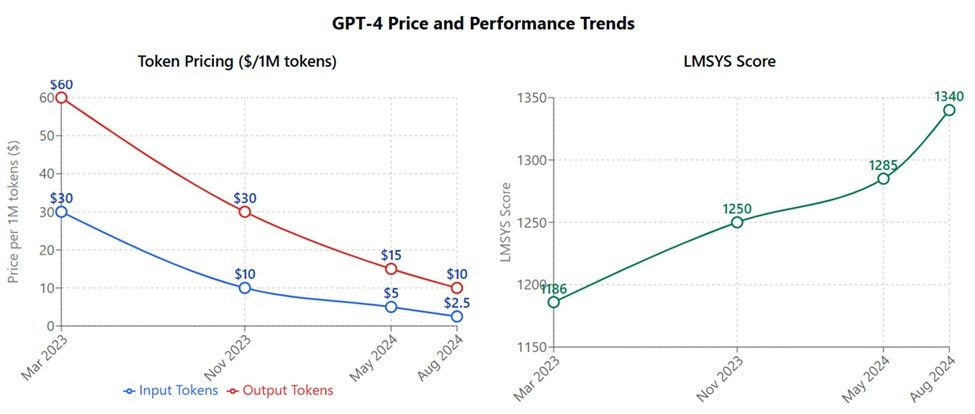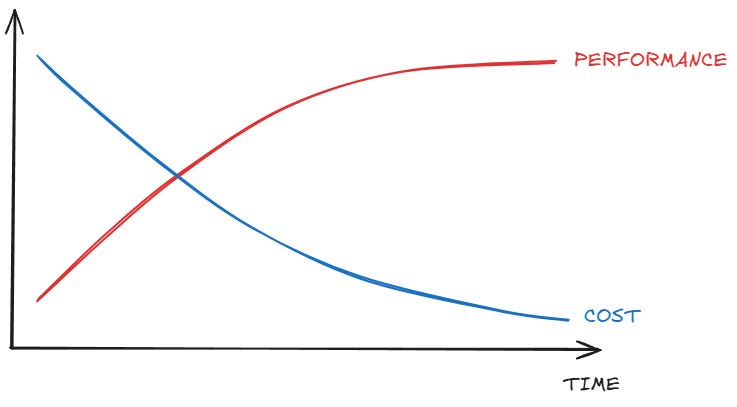This article is part 3 of a seven-part series on The State of AI, 2025. (Part 1, part 2)
It’s unfortunate timing to publish a post about AI getting cheaper right as The Information leaks that OpenAI is planning to offer—in line with a thesis I laid out last year—$2,000/month, $10,000/month, and even $20,000/month AI products for software development and PhD research—but bear with me.
I have to attend a wedding soon. I walk into a tailor’s shop on Savile Row, London, and ask for a suit. The tailor nods, measures me in silence, and, after a moment, says, “Four thousand pounds.” I blink. “For a suit?” The tailor doesn’t even look up. “For this suit.” It’s bespoke suits. It’s first-edition Hemingways. It’s A5 Kobe, perfectly seared. It’s front-row at the Met. It’s a table at the Ritz, no reservation needed and no reservations given. Maybe even a private omakase at Sukiyabashi Jiro.
But what do I know, my budget is only enough to see The Menu. (This newsletter is not that successful.) All that is to state in a fancy way what’s actually a platitude: better costs more. You pay every extra ounce of quality. Not everyone here has traveled to a luxury resort or fought over who inherits the family’s media billionaire conglomerate, yet we all know that’s how this works. And then there’s AI.
A simplified graph, yes, but a surprisingly faithful one. Let’s take the API pricing of OpenAI’s models as an example: GPT-3.5 (powered the original ChatGPT) was better than GPT-3, yet much cheaper to run. GPT-4 Turbo was better and cheaper than GPT-4. GPT-4o is better than all of them—and still cheaper. Then you have the mini versions (GPT-4o mini, o1-mini, o3-mini); almost as good as their respective counterparts at 1/10-20x of the cost. (GPT-4.5 is expensive but also a giant anomaly.)
The same thing applies to Google’s and Anthropic’s models. Open-source models—ahem, DeepSeek—are getting so efficient that what once required a server farm the size of Luxembourg (not much, but still) now runs locally on a MacBook.
The laws of economic gravity are bending under the weight of top-notch efficiency gains. The tendency is clear: intelligence too cheap to meter. (Except when it’s a $20k monthly sub for a fancy research assistant; can’t wait for DeepSeek to fix this insanity.)
I see. You’ve realized the graph above is actually a drawing that I did and now you want the real thing to confirm I’m not making this up. Ok, below are two graphs shared by Professor Ethan Mollick that perfectly capture the inverse relationship between cost and performance in AI models (benchmarks: LMSys Arena and GPQA Diamond):


Look at that. AI belongs to the upside-down world. But of course, this isn’t a miracle. It’s a confluence of factors—technical, economic, and strategic—that make AI one of those rare things that improve in quality while costing less.
Rare at least to most people, who, for some reason, insist on caring primarily about stuff that costs more over time like education, healthcare, housing, and other minutiae. Those things, perhaps more of a basic need than having a brand-new quadruple-camera iPhone 16 Plus Pro, suffer from cost disease, a well-known but apparently incurable illness. You can see the dichotomy reflected in this infamous chart:
AI has its share of ailments (it’s especially prone to perceptual disorders) but cost disease isn’t one of them. If you want a modern equivalent, don’t look at education but at something far more important: a TV. What started as a prohibitively expensive (and heavy) luxury became so cheap (and good) that corporations practically throw it at you, free, as long as you don’t mind being bombarded with pharmaceutical and fast-food ads.
(And then you go buy Ozempic at the pharmacy, which is quietly in bed with a media giant caught in a billionaire feud—oh, and also with McDonald’s and Burger King, whose burgers may not be A5 Kobe, but hey, they’re cheap.)
(On a more serious note: I’m happy that AI costs less over time but it’s unacceptable that basic services don’t.)
We just saw the what, now let’s explore the why.
